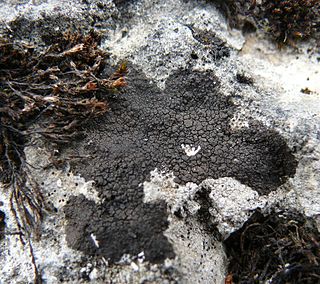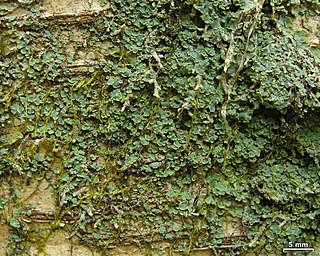
Genus is a taxonomic rank above species and below family as used in the biological classification of living and fossil organisms as well as viruses. In binomial nomenclature, the genus name forms the first part of the binomial species name for each species within the genus.

A lichen is a hybrid colony of algae or cyanobacteria living symbiotically among filaments of multiple fungi species, along with yeasts and bacteria embedded in the cortex or "skin", in a mutualistic relationship. Lichens are the lifeform that first brought the term symbiosis under biological context.

The Cladoniaceae are a family of lichen-forming fungi in the order Lecanorales, comprising about 560 species distributed amongst 18 genera. This family is one of the largest among lichen-forming fungi and is globally distributed, from Arctic tundra to tropical rainforests, favouring humid environments while being intolerant of arid conditions. Molecular phylogenetics has significantly advanced the understanding of their complex taxonomic history, revealing intricate evolutionary relationships and leading to a refined classification. Notable members include reindeer moss and cup lichens of the genus Cladonia, which consist of about 500 species and forms a significant part of the diet for large mammals in taiga and tundra ecosystems.
In mycology, the terms teleomorph, anamorph, and holomorph apply to portions of the life cycles of fungi in the phyla Ascomycota and Basidiomycota:

Cyanolichens are lichens in which the fungal component partners with cyanobacteria for photosynthesis, rather than the green algae found in most other lichens. In some cyanolichens, known as bipartite forms, the cyanobacteria form an extensive photobiont layer throughout the main thallus. Others, called tripartite lichens, contain both green algae and cyanobacteria, with the latter often confined to specialised wart-like structures known as cephalodia. This arrangement reflects the remarkable diversity within cyanolichens, which can feature filamentous or unicellular cyanobacteria, sometimes exhibiting multiple independent evolutionary origins across different fungal lineages.

Trebouxia is a unicellular green alga. It is a photosynthetic organism that can exist in almost all habitats found in polar, tropical, and temperate regions. It can either exist in a symbiotic relationship with fungi in the form of lichen or it can survive independently as a free-living organism alone or in colonies. Trebouxia is the most common photobiont in extant lichens. It is a primary producer of marine, freshwater and terrestrial ecosystems. It uses carotenoids and chlorophyll a and b to harvest energy from the sun and provide nutrients to various animals and insects.

The Roccellaceae are a family of mostly lichen-forming fungi in the order Arthoniales, established by the French botanist François Fulgis Chevallier in 1826. Species in the family exhibit various growth forms, including crustose and fruticose (shrub-like) thalli, and diverse reproductive structures. Roccellaceae species typically have disc-like or slit-like fruiting bodies, often with distinct blackened margins. Molecular phylogenetics studies have revealed considerable genetic diversity and complex evolutionary histories within the family.

Verrucariaceae is a family of lichens and a few non-lichenised fungi in the order Verrucariales. The lichens have a wide variety of thallus forms, from crustose (crust-like) to foliose (bushy) and squamulose (scaly). Most of them grow on land, some in freshwater and a few in the sea. Many are free-living but there are some species that are parasites on other lichens, while one marine species always lives together with a leafy green alga.

A lichenicolous fungus is a member of a specialised group of fungi that live exclusively on lichens as their host organisms. These fungi, comprising over 2,000 known species across 280 genera, exhibit a wide range of ecological strategies, including parasitism, commensalism, and mutualism. They can be found in diverse environments worldwide, from tropical to polar regions, and play important roles in lichen ecology and biodiversity. Lichenicolous fungi are classified into several taxonomic groups, with the majority belonging to the Ascomycota and a smaller portion to the Basidiomycota. Their interactions with host lichens range from mild parasitism to severe pathogenicity, sometimes causing significant damage to lichen communities.

Lichens are symbiotic organisms made up of multiple species: a fungus, one or more photobionts and sometimes a yeast. They are regularly grouped by their external appearance – a characteristic known as their growth form. This form, which is based on the appearance of vegetative part of the lichen, varies depending on the species and the environmental conditions it faces. Those who study lichens (lichenologists) have described a dozen of these forms: areolate, byssoid, calicioid, cladoniform, crustose, filamentous, foliose, fruticose, gelatinous, leprose, placoidioid and squamulose. Traditionally, crustose (flat), foliose (leafy) and fruticose (shrubby) are considered to be the three main forms. In addition to these more formalised, traditional growth types, there are a handful of informal types named for their resemblance to the lichens of specific genera. These include alectorioid, catapyrenioid, cetrarioid, hypogymnioid, parmelioid and usneoid.

Lichen morphology describes the external appearance and structures of a lichen. These can vary considerably from species to species. Lichen growth forms are used to group lichens by "vegetative" thallus types, and forms of "non-vegetative" reproductive parts. Some lichen thalli have the aspect of leaves ; others cover the substrate like a crust, others such as the genus Ramalina adopt shrubby forms, and there are gelatinous lichens such as the genus Collema.

Lichen anatomy and physiology is very different from the anatomy and physiology of the fungus and/or algae and/or cyanobacteria that make up the lichen when growing apart from the lichen, either naturally, or in culture. The fungal partner is called the mycobiont. The photosynthetic partner, algae or cyanobacteria, is called the photobiont. The body of a lichens that does not contain reproductive parts of the fungus is called the thallus. The thallus is different from those of either the fungus or alga growing separately. The fungus surrounds the algal cells, often enclosing them within complex fungal tissues unique to lichen associations. In many species the fungus penetrates the algal cell wall, forming penetration pegs or haustoria similar to those produced by pathogenic fungi. Lichens are capable of surviving extremely low levels of water content (poikilohydric). However, the re-configuration of membranes following a period of dehydration requires several minutes at least.

Symbiosis in lichens is the mutually beneficial symbiotic relationship of green algae and/or blue-green algae (cyanobacteria) living among filaments of a fungus, forming lichen.
Racoleus is a genus of two species of lichen-forming fungi of uncertain familial placement in the order Capnodiales. Both species of Racoleus are filamentous lichens with Trentepohlia as the photobiont partner. The lichens form thalli in the form of felt-like, blackish-brown cushions that grow under shaded conditions on siliceous rocks.

Multiclavula mucida is a globally distributed species of basidiolichen belonging to the family Hydnaceae. Since its initial classification by Christiaan Hendrik Persoon in 1797, the species has been described under various synonyms and associated with multiple genera. Persoon described its fruiting bodies as gregarious, varying from simple to branching structures, predominantly whitish in colour with yellow to brownish tips. He also noted its frequent appearance in autumn on decaying, moist wood, often covered with a greenish crust necessary for its growth.

Normandina pulchella, commonly known as the elf-ear lichen or blue heart, is a species of squamulose lichen in the family Verrucariaceae. This cosmopolitan species is widely distributed across both hemispheres, where it thrives in moist microhabitats. It favours moss-covered deciduous trees and rocks, often colonising over mosses and bryophytes. It occasionally grows on bare bark and on other lichens. Distinctive features of N. pulchella include its bluish-green squamules (scales) with sharply raised margins, non-reactivity to standard chemical spot tests, and growth in humid habitats. Initially, Nannochloris normandinae, a green alga, was thought to be its photobiont. More recent studies, however, have revised this understanding, with Diplosphaera chodatii now recognised as the algal partner.

Serusiauxia is a monotypic fungal genus in the family Pyrenulaceae. It contains a single species, Serusiauxia inexpectata, a corticolous (bark-dwelling), crustose lichen found in Mauritius. Serusiauxia is morphologically distinct within the Pyrenulaceae due to its sorediate thallus and chemistry involving gyrophoric acid, a combination of characteristics that is not observed in any other Pyrenulaceae genera.
Erinacellus is a genus of lichen-forming fungi of uncertain familial placement in the order Peltigerales. It consists of two species. These lichens are characterised by their dense, cushion-like growths composed of erect, thread-like branches, which resemble miniature hedgehogs. The genus was established in 2014 and is named after the hedgehog genus Erinaceus, reflecting its appearance. Erinacellus forms a symbiotic relationship with Hyphomorpha, a type of cyanobacteria. While the genus is placed within the order Peltigerales, its exact position within this group remains uncertain. The two species, E. dendroides and E. schmidtii, are found in different parts of the world, with E. dendroides occurring in New Zealand and North America, and E. schmidtii in Thailand and Sri Lanka. These lichens typically grow in moist environments, such as coastal areas and tropical regions, and can be found on both rocks and tree bark.
Pyrenothrix is a small genus of lichen-forming fungi in the family Pyrenotrichaceae. It comprises two species of filamentous lichens, which are organisms formed by a symbiotic relationship between fungi and photosynthetic partners. The genus is characterized by its unique structure, featuring densely arranged filaments composed of cyanobacteria wrapped in fungal threads. Pyrenothrix species form dark greyish-brown growths on various surfaces, with one species found on tree bark and the other on leaves in tropical forests. The genus was circumscribed in 1917 by American scientist Lincoln Ware Riddle, based on specimens collected in Florida. Pyrenothrix is distinguished from other lichens by its intricate cellular structure and reproductive features, including specialized spore-producing structures.















